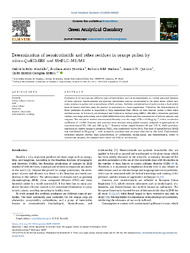Embrapa Environment
 Web Content Display
Web Content Display
Publications
 Busca de Publicações
Busca de Publicações
Determination of neonicotinoids and other residues in orange pollen by micro-QuEChERS and UHPLC–MS/MS.
Author(s): ALMEIDA, G. B.; FERREIRA, J. A.; BARIZON, R. R. M.; QUEIROZ, S. C. do N. de; BOTTOLI, C. B. G.
Summary: Abstract:Producers of citrus crops use different types of insecticides, such as neonicotinoids, to combat pests and diseases of these cultures. Neonicotinoids are systemic insecticides and are translocated to the plant tissue, which may leave residues in pollen and cause adverse effects on bees. Pesticide contamination of pollen is also a food safety issue in human nutrition since the product is consumed as a food supplement. Therefore, the determination of these pesticides in pollen is important to help understand their effects on bees because pollen is their main nutrient source. In this work, we developed and validated a method using UHPLC–MS/MS to determine pesticide residues in orange pollen using micro-QuEChERS extraction, which uses low consumption of solvent, sample, and reagents. The analytical method demonstrated linearity over the range of 50 to 1000 ?g kg?1, with a correlation coefficient of ?0.990. Trueness and precision were assessed using spiked samples, analyzed in quintuplicate at concentrations of 50, 100, and 200 ?g kg?1. Trueness values ranged between 81 and 115 %, while precision, expressed as relative standard deviation (RSD), was consistently below 20 %. The limit of quantification (LOQ) was established at 50 ?g kg?1, with acceptable precision and accuracy observed at this level. Experimental treatment samples showed high concentrations of clothianidin, imidacloprid, and thiamethoxam, while in commercial samples, the analytes were below the LOQ or not detected.
Publication year: 2025
Types of publication: Journal article
Unit: Embrapa Environment
Keywords: Análise Química, Bee pollen, Citrus, Colony collapse disorder, Cromatografia, Espectrometria, Inseticida Sistêmico, Laranja, Liquid chromatography, Neonicotinoid insecticides, Pesticide residues, Pólen, Representative sampling, Resíduo Quimico, Systemic insecticides, Tandem mass spectrometry
